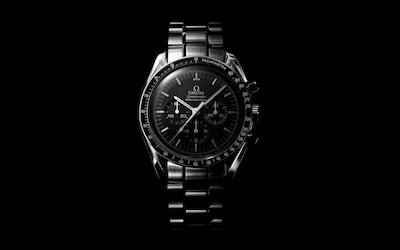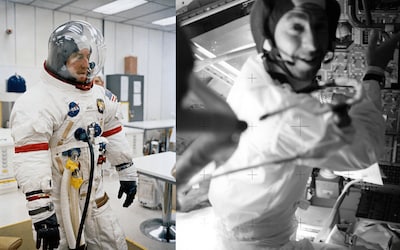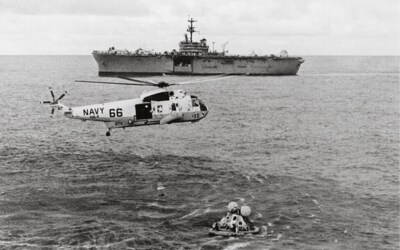OMEGA: 50 Years Since Apollo 13
By Sarah Jayne Potter | 3 minute read

OMEGA Speedmaster
When it comes to iconic collaborations, you can’t get more epic than a partnership with NASA. OMEGA, in particular the Speedmaster, has been a choice of astronauts and space agencies for more than half a century and even became the first watch worn on the Moon in July 1969. That wasn’t the only trip that OMEGA lent a hand to, and on April 11th 1970, veteran astronaut James Lovell, Command Module Pilot Jack Swigert, and Lunar Module Pilot, Fred Haise all wore OMEGA Speedmaster Professional Chronographs on their infamous Apollo 13 mission.

OMEGA Speedmaster
It wasn’t just a fashion choice when it came to wearing the watches, however. The timepieces played a vital part in ensuring the astronauts landed back home safely after such a dramatic and near disastrous mission. As described by James Ragan, the NASA engineer who first tested and qualified the OMEGA Speedmaster in 1964, “The watch was a critical backup. If the astronauts ever lost the capability of talking to the ground, or the capability of their digital timers, the only thing they would have to rely on would be the watches on their wrists. It needed to be there for them if they had a problem.”

Astronaut James Lovell
Unfortunately, there was a problem for Apollo 13. Just two days after launch, an oxygen tank exploded on board, crippling the Service Module and the mission was abandoned. The crew had to turn back round, and time was running out to do that safely! To conserve energy, the crew shut down nearly all power – rendering their digital timers obsolete, and leaving the astronauts at the mercy of dark and freezing conditions.

Apollo 13 launch and view of damaged service model
The return was perilous, and NASA worked around the clock to ensure the astronauts were returned back safely, and it was at the final hurdle when OMEGA’s essential precision was called for. Because the mission had drifted off course by roughly 60 to 80 nautical miles, it meant that the module would re-enter Earth’s atmosphere at the wrong angle, and bounce back into space with no chance of recovery.

Apollo 13 crew recovery after splashdown
Therefore, to manually readjust the course of the craft, an exact 14-second burn of fuel was required. There was simply no room for error. Without their digital timers, Swigert instead used his OMEGA Speedmaster chronograph to time the burn, while Lovell guided the craft using the Earth’s horizon as his guide. As Mission Commander James Lovell would later say, “We used the OMEGA watch that Jack had on his wrist and I had to control the spacecraft. Jack timed the burn on the engine to make that correction to get us back home safely.”
To huge relief, the unique manoeuvre worked perfectly, and finally, on April 17th, 142 hours and 54 minutes after launch, Apollo 13 splashed down safely in the South Pacific Ocean.
The watch had played its part, and performed exactly as intended.
On October 5th 1970, OMEGA was presented with NASA’s “Silver Snoopy Award” and the sterling silver lapel pin is a prized reminder of OMEGA’s history in space exploration, and especially the major role it played in the “successful failure” of Apollo 13.
Therefore, to manually readjust the course of the craft, an exact 14-second burn of fuel was required. There was simply no room for error. Without their digital timers, Swigert instead used his OMEGA Speedmaster chronograph to time the burn, while Lovell guided the craft using the Earth’s horizon as his guide. As Mission Commander James Lovell would later say, “We used the OMEGA watch that Jack had on his wrist and I had to control the spacecraft. Jack timed the burn on the engine to make that correction to get us back home safely.”
To huge relief, the unique manoeuvre worked perfectly, and finally, on April 17th, 142 hours and 54 minutes after launch, Apollo 13 splashed down safely in the South Pacific Ocean.
The watch had played its part, and performed exactly as intended.
On October 5th 1970, OMEGA was presented with NASA’s “Silver Snoopy Award” and the sterling silver lapel pin is a prized reminder of OMEGA’s history in space exploration, and especially the major role it played in the “successful failure” of Apollo 13.
